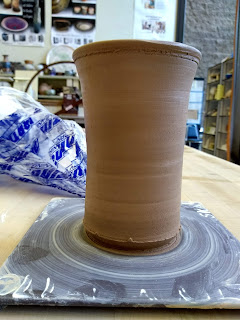I'm struck by all the interest in sharing the story of a pot with the selling of the pot. Etsy suggests to its vendors that we add stories to our shop listings of what we make and offer there for sale. A story about the making, the inspiration, ourselves. They say buyers want to know the maker somewhat. I get it; when you buy a pot, or anything else online, what contact do you have with the maker? And if you like the personal aspects of handmade things, maybe you want touch with the person who made what you choose.
I visit potters as I travel, and usually buy something as part of a
visit. Several years ago, I followed the picture of a wonderful pitcher
to the maker, Fran Tristram, in Nottingham, UK. One of those pitchers
sat on her crowded kitchen windowsill, a familiar piece of useful
equipment. (Can't show you a picture; I bought something smaller to
carry home, and she has moved onto other forms.) But the pitcher on the
windowsill is a treasured memory, and the pot I bought from her makes
the same kind of connection, as a souvenir for me of our meeting. So,
yes, the experience adds a layer of knowing and I enjoyed the contact with the potter,
but I focus mostly on the pot.
In the October 2016 issue of Ceramics Monthly, there are a couple of articles about potters who collect pottery. Matt Scheimann collects cups, and wants to know his guests' stories: what attracts them to the cups they choose to use from his collection: "the interaction between the user and the pot".
Brian Harper and Tiffany Charbonneau began collecting by trading, and so start with a connection to the other potters from whom they collect." To us, that makes the collection personal and meaningful and acts as a record of our life experience."
The story of the maker or the making is one context which the object carries. It's the usual context for art: what was the artist doing? Art objects are presented as things valued and experienced in themselves, and their scholarly context is mostly about the artist. In contrast, anthropology museums exhibit things from other cultures in their context of use, where they came from. Not so much objects on pedestals, as dioramas of life. More like Schiemann's guests' stories, where choice and use by the owner/user is the relevant context.
Here's the "art object" picture, an object alone, with minimal context (my pot).
There's a move now to display objects for sale with a decorative or imagined background, as if they are in someone's life.
Yes, I have a background in anthropology. Yes, I taught interior design students and pushed them to accept that the owners and users of the places they design want to claim those spaces, put their marks on them, own them. The design eventually belongs to the user, not the designer.
A store or fair booth is a transition between these "ownerships", where I offer my pots to become yours.
Maybe that's my unease with the story being the maker's story. I call my Etsy shop "Pots to Live With". I want my pottery to end in someone's life, being used, being comfortable. Yes,
the context that matters to me is not the artists', nor the museum visitors', but the users'. Take them home.





















































